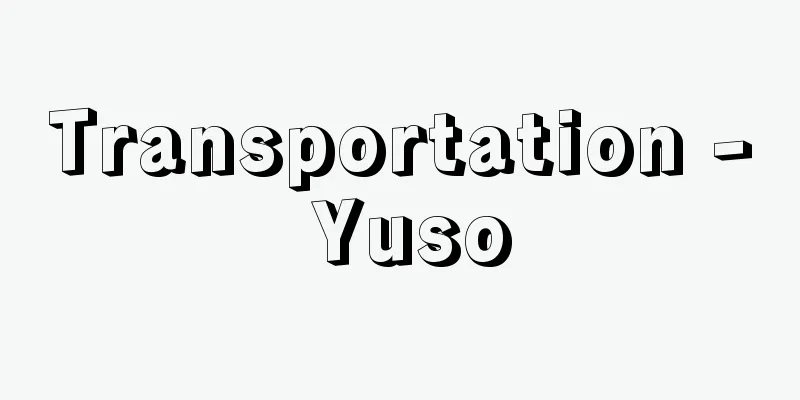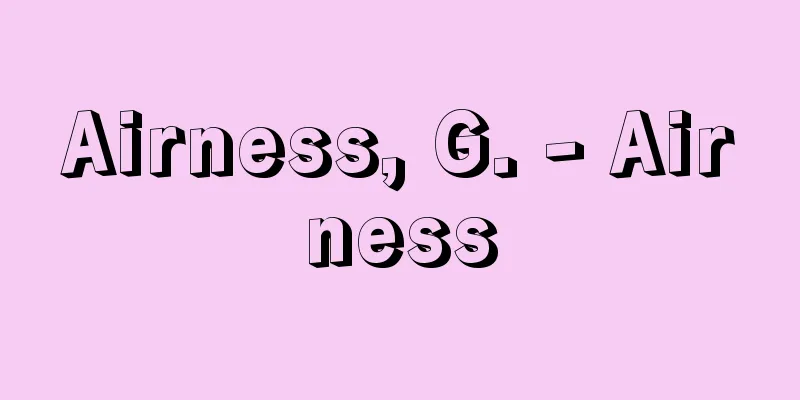Transportation - Yuso

|
Transportation is generally defined as the spatial movement of people and cargo at human will through facilities that are publicly available. Spatial movement based on human will does not mean movement as a natural phenomenon, but movement that humans undertake with a certain purpose to overcome spatial distance. Movement through socially open facilities does not mean movement of people and goods for production, sales, work, and learning within the same management entity, but movement through publicly available facilities such as roads, railways, ships, and aircraft. Traffic and transportation are very similar concepts, but traffic has a broader meaning than transportation. Traffic includes not only the spatial movement of people and goods, but also the spatial movement of human thoughts, emotions, and information, which is called communication. [Hiroshi Nomura] TransportationTransportation means are necessary to move people and cargo from one place to another. Transportation means consist of three labor means: passages, vehicles, and power. Passages are facilities for moving people from one place to another, and include railways, roads, rivers, lakes, oceans, airways, and pipelines. Vehicles are labor means that transport objects such as people and cargo by these passages, and move them from one place to another. They correspond to the physical characteristics of the passage they use, and include railway passenger cars and freight cars, automobiles, ships, and airplanes. Power is the means by which the vehicles move along the passages, and currently mechanical power such as petroleum-based power and electric power is mainly used. Over the long history of transportation, wind power, as seen in sailing ships, animal power, as seen in horse-drawn carts, and sometimes human power, as seen in carts and rickshaws, were also used. [Hiroshi Nomura] Transportation ServicesThe characteristic of the transportation service (utility) produced by a transportation agency is that, unlike the production of other goods, it does not bring about any physical changes to the object of transportation, but only a change in location. Furthermore, the production process of a transportation service is at the same time the consumption process of that service. In other words, transportation is characterized by its immediacy. Furthermore, items that indicate the characteristics of a transportation service include high speed, promptness, economy, comfort, convenience, and safety, and depending on the country or region, the level of public safety may also be added. There are two types of transportation: private transportation, which is transportation by individuals or companies for themselves, and commercial transportation, which is transportation for other people or companies. Specifically, in the case of automobiles, personal cars and company trucks are used for private transportation, while taxis, route buses, tourist buses, special combined trucks (route trucks under the Road Transportation Act before the deregulation of 1989), and general trucks (regional and chartered trucks before the deregulation) are used for commercial transportation. In railroads, shipping, and aviation, commercial transportation is overwhelmingly more common. Companies in charge of these commercial transportations are transportation companies, and the collection of transportation companies of the same type is the transportation industry for each mode of transportation. [Hiroshi Nomura] Transportation IndustryThe establishment and development of the modern transportation industry is closely related to the emergence and development of capitalism. Before the establishment of capitalism, transportation was mainly for personal use, but with the establishment of capitalism, commercial transportation, which transports other people and their cargo, was separated from personal transportation and became independent, and modern transportation industries such as railroads and shipping were established. With the invention of the steam engine, railroad companies and steamship companies sprung up, and the transportation industry experienced a great prosperity. Furthermore, at the beginning of the 20th century, new technological innovations such as internal combustion engines such as gasoline engines appeared, and the automobile and air transportation industries flourished. As a result, competition arose between the traditional transportation industries of railroads and shipping and the new transportation industries of automobiles and aviation, but the results have progressed in favor of the latter. The division and privatization of the Japanese National Railways into the various JR companies was also a result of railway transportation entering into fierce competition with other transportation modes and losing its monopoly in the land transportation market. In particular, the advancement of motorization has reduced the demand for public transportation such as railways, trams, and route buses, and in some depopulated areas and cities, these transportation services have been suspended, resulting in the problem of the so-called transportation poor. The transportation poor include the elderly, children, pregnant women, people with disabilities, and the poor. In recent years, the problem of the elderly has become particularly serious. When it is deemed necessary to maintain the mobility of these people, the national and local governments have made various efforts, such as providing subsidies and operating community buses. Commercial transport has a public nature in that it transports an unspecified number of passengers and cargo for an unspecified number of shippers. For this reason, many transport industries have historically been subject to various government regulations, such as restrictions on the entry and exit of transport companies, fare levels and systems, and service levels such as timetables. However, the trend toward economic deregulation, centered on Europe and the United States, has also spread to the transport industry in other countries, and transport regulations have been abolished or relaxed. Transport regulations have also been significantly relaxed in Japan. [Hiroshi Nomura] Deregulation in JapanDeregulation in Japan began in the 1990s. As in the United States, the transportation industry took the lead, resulting in major changes in the industry. The reason for regulation lies in the public nature of the transportation industry. There are two types of regulation: economic regulation (regulation of entry and exit, regulation of service quality, regulation of fares) and social regulation (consumer protection, worker protection, ensuring safety, environmental conservation, etc.). Deregulation refers to the relaxation of the former, economic regulations, and this relaxation is generally accompanied by the strengthening of social regulations. In the United States, deregulation literally meant the abolition of regulations, but in Japan it is unique in that it refers to deregulation. Looking at the progress of deregulation, the Trucking Business Law was enacted in 1989, followed by the Aviation Law in 2000, the Railway Business Law in the same year, and the Road Transportation Law for buses, hire cars, taxis, etc. in February 2002, and the legal system through deregulation was completed. As a result, the supply and demand adjustment by entry and exit regulations was changed to market dependence, the liberalization of services allowed the establishment and elimination of new routes, and the flexibility of freight rate regulations was relaxed. On the one hand, positive effects such as lower fares and improved services were seen in each transportation industry. However, on the other hand, excessive entry of companies into the transportation market has resulted in a deterioration of business conditions, a decline in wage levels due to a decline in profitability, deterioration of working conditions such as long working hours and long driving hours, and sometimes a decline in safety due to the occurrence of serious accidents. In addition, supply disruptions such as the closure of air, rail, and bus routes to local areas with low demand have also been seen. Some people are of the opinion that reregulation is necessary. In any case, maintaining the public nature of transportation as infrastructure for the survival of society is essential, and careful adjustments will need to continue in the future. [Hiroshi Nomura] IssuesAs long as transportation involves the movement of people and goods from one place to another, pollution will occur as the vehicles move. This can be air pollution from exhaust gases, ocean pollution from discharged oil, noise and vibrations along roads and around airports, and even radio interference. Social regulations are imposed on each transportation system to control this pollution, and each industry is making efforts to prevent it. [Hiroshi Nomura] "The Transportation Industry" by Nomura Hiroshi (1980, Toyo Keizai Shinposha)" ▽ "Transportation Industry Theory" edited by Shiomi Eiji (1994, Hakuto Shobo)" ▽ "The Nightmare of Deregulation" by Uchihashi Katsuhito et al. (1995, Bungeishunju)" ▽ "Deregulation: Slashing the Illusion of Public Interest" by Nakajo Ushio (1995, Toyo Keizai Shinposha)" ▽ "Distribution-Related Laws You Should Know" edited by Nojiri Toshiaki (1998, Hakuto Shobo)" ▽ "Transportation Economics Handbook" edited by the Japan Society of Transportation Studies (2011, Hakuto Shobo) [Reference items] | | | | | | | |Source: Shogakukan Encyclopedia Nipponica About Encyclopedia Nipponica Information | Legend |
|
輸送とは、一般的に、人間の意志に基づく人および貨物の、社会的に公開された施設による場所的移動である、と定義される。 人間の意志に基づく場所的移動とは、自然現象としての移動ではなく、人間がある目的をもって行う、場所的懸隔を克服するための移動であることを意味する。社会的に公開された施設による移動とは、同一経営体内部における生産、販売、業務そして学習などのための人および財貨の移動ではなく、公衆の利用できる公開された施設、たとえば道路、鉄道、船舶および航空などのような施設による移動であることを意味する。 交通と輸送とは非常に類似した概念であるが、交通のほうが輸送より広範な内容をもっている。交通には、人および貨物の場所的移動に加えて、通信という人間の思想、感情および情報などの場所的移動が含まれている。 [野村 宏] 輸送手段人および貨物の場所的移動のためには、輸送手段が必要になる。輸送手段は通路、運搬具および動力という三つの労働手段から成り立っている。通路は場所的移動のための施設で、鉄道、道路、河川、湖沼、海洋、空路、パイプラインなどがある。運搬具は、これら通路によって、人や貨物という輸送対象を積載して場所的移動を行う労働手段であり、それぞれ利用する通路の物理的特性に対応し、鉄道客車・貨車、自動車、船舶、航空機などがある。動力は通路によって運搬具を移動させる手段であり、現在では、主として石油系動力、電気動力などの機械力が使用されている。輸送の長い歴史の過程では、帆船にみられるような風力、荷馬車にみられるような畜力、ときには荷車や人力車のように人力なども使用された。 [野村 宏] 輸送サービス輸送機関の生産する輸送サービス(用役)の特性は、他の商品生産の場合とは異なり、輸送対象になんらの物質的変化を与えず、ただ場所的変化をおこすのみであること。また、輸送サービスの生産過程は、同時にそのサービスの消費過程である。つまり、輸送は即時性をもつことに特徴がある。さらに、輸送サービスの特性を示す項目としては、高速性、迅速性、経済性、快適性、便利性、安全性などの項目があるが、国や地域によっては治安度をも加えることもある。 輸送には、個人や企業が自己のために輸送する自家用輸送と、他人や他の企業のために輸送する営業用輸送の2種がある。具体的にいえば、自動車ではマイカーやカンパニー・トラックは自家用輸送を行い、タクシー、路線バス、観光バス、特別積合せトラック(1989年の規制緩和以前の道路運送法では、路線トラック)、一般トラック(規制緩和以前では、区域・貸切トラック)などは営業用輸送を行っている。鉄道、海運そして航空などにあっては、営業用輸送が圧倒的に多い。そして、これら営業用輸送を担当する企業が輸送企業であり、同一種類の輸送企業の集合体が各機関別の輸送産業である。 [野村 宏] 輸送産業近代的意味をもつ輸送産業の成立とその発展は、資本主義の発生、発展と密接な関係をもっている。資本主義成立以前には、主として自家用輸送が輸送の中心であったが、成立とともに自家用輸送から他人や他人の貨物の輸送を行う営業用輸送が分離独立し、鉄道や海運という近代的な輸送諸産業が成立した。蒸気機関の発明によって、鉄道会社、汽船会社が群出し、輸送産業は非常な隆盛を迎えた。さらに、20世紀に入ると、新しい技術革新としてガソリンエンジンなどの内燃機関が出現し、自動車輸送や航空輸送の諸産業が隆盛を迎えた。その結果、鉄道、海運という在来の輸送産業と、自動車、航空という新しい輸送産業の間の競争が生じたが、結果は、後者の有利のうちに推移している。 日本国有鉄道のJR各社への分割・民営化も、鉄道輸送が、他の輸送機関と激しい競争関係に入り、陸上輸送市場における独占性を喪失した結果である。とくに、モータリゼーションの進行により、鉄道、路面電車、路線バスなどの公共的輸送機関の需要が減少し、過疎地域や都市の一部では、これらの輸送サービスの提供が停止される事態となり、いわゆる交通弱者the transportation poor問題が発生した。交通弱者とは、高齢者、子ども、妊婦、障害者そして貧困者などをさす。近年はとくに高齢者問題が大きくなっている。これらの人々のモビリティ(動きやすさ、可動性)を維持することが必要と判断された場合には、国あるいは地方自治体等が種々の努力を重ねている。補助金の交付、コミュニティバスの運営等がそれである。 営業用輸送には、不特定多数の乗客や不特定多数の荷主の貨物を運ぶという公共性がある。そのため、運輸企業の参入および退出の規制、運賃水準および制度の規制、ダイヤなどサービス水準の規制など、政府による種々の規制が歴史的に課せられている輸送産業が多い。しかし、欧米を中心とした経済規制緩和の動向は、各国の運輸産業にも及び、運輸規制の廃止もしくは緩和が進行した。また、日本においても運輸規制は大幅に緩和されている。 [野村 宏] 日本の規制緩和日本における規制緩和deregulationは、1990年代より行われた。アメリカの場合と同じように輸送産業が先行し、その結果輸送業界に大きな変化が生じた。 規制の理由は輸送産業の公共性にある。規制には、経済的規制(参入退出の規制、サービスの質の規制、運賃料金の規制)と、社会的規制(消費者保護、労働者保護、安全の確保、環境保全等)の2種がある。規制緩和とは前者の経済的規制の緩和をさし、この緩和に伴って、他方では社会的規制の強化が行われるのが一般的である。アメリカではデレギュレーションは文字どおり規制撤廃であったが、日本では規制緩和となっている点に特徴がある。 規制緩和の進行をみると、1989年(平成1)の貨物自動車運送事業法、やや遅れて2000年(平成12)に航空法、また同年に鉄道事業法、2002年2月にバス、ハイヤー、タクシー等に関する道路運送法が、陸続として改正され規制緩和による法体系はいちおうの完成をみせた。その結果、参入退出規制による需給調整から市場依存へ、サービスの自由化によるルートの新設・撤廃の自由化、運賃料金規制の緩和による弾力化などが行われた。そして一方では、各輸送産業において、運賃料金の低下、サービスの向上などの積極的効果がみられた。しかし他方では、輸送市場への企業の過剰参入、その結果としての経営状態の悪化、収益力の低下による賃金水準の低下、長時間労働・長時間運転の発生など、労働条件の低下、ときには重大事故の発生といった安全性の低下などがみられるようになった。また、需要の少ないローカル地域への航空・鉄道・バスの路線廃止といった供給途絶などもみられるようになった。そこで一部には再規制reregulationが必要とする意見も出ている。ともかく、社会存続のためのインフラストラクチャーとして、輸送の公共性を維持することは不可欠で、今後も慎重な調整を続ける必要がある。 [野村 宏] 問題点輸送が人および財貨の場所的移動である限り、運搬具の走行に伴う公害が生ずる。排ガスによる大気汚染、排出油による海洋汚染、道路沿線や空港周辺の騒音・振動、さらには電波障害などがそれであり、各輸送機関にはこうした公害を抑制するための社会的規制が課され、それぞれの産業はその防止に努力している。 [野村 宏] 『野村宏著『輸送産業』(1980・東洋経済新報社)』▽『塩見英治編著『交通産業論』(1994・白桃書房)』▽『内橋克人他著『規制緩和という悪夢』(1995・文芸春秋)』▽『中条潮著『規制破壊――公共性の幻想を斬る』(1995・東洋経済新報社)』▽『野尻俊明編著『知っておきたい流通関係法』(1998・白桃書房)』▽『日本交通学会編『交通経済ハンドブック』(2011・白桃書房)』 [参照項目] | | | | | | | |出典 小学館 日本大百科全書(ニッポニカ)日本大百科全書(ニッポニカ)について 情報 | 凡例 |
Recommend
Antimonic acid - Antimony-san (English spelling)
Antimony pentoxide is the name of the hydrate of S...
Ivan [III] - Ivan
Grand Prince of Moscow and Prince of All Russia (r...
Deep-fried tofu - Ageda Shidofu
Tofu is coated with potato starch, lightly fried, ...
Allium schubertiii - Allium schubertiii
...A few leaves usually develop in early spring, ...
prurigo Besnier (English spelling) prurigoBesnier
...In childhood, itchy rice-grain-sized rashes ap...
Belize - Belize (English spelling)
Located in the northeast of the Central American ...
Permafrost
The part where the moisture in the soil or in the ...
Subpoena for documents -
In the evidence gathering procedure of a civil law...
Buttoko (English spelling) fó tú hù
Subjugated people of Buddhist sects in China. They...
"Ying Kui Law Journal" - Ei Kei Law Journal
...This is a useful book for examining the poetry...
Hokou method
This was one of the new laws of Wang Anshi (1021-...
Hallucination - genkaku
The definition of illusions and hallucinations in...
Dieng Plateau
A 2,060m-high caldera located about 120km northwes...
Russula emetica (Russula emetica)
Basidiomycetes, order Matsutake, family Russulacea...
Archipelago
…The Greek islands are the largest in the world, ...









